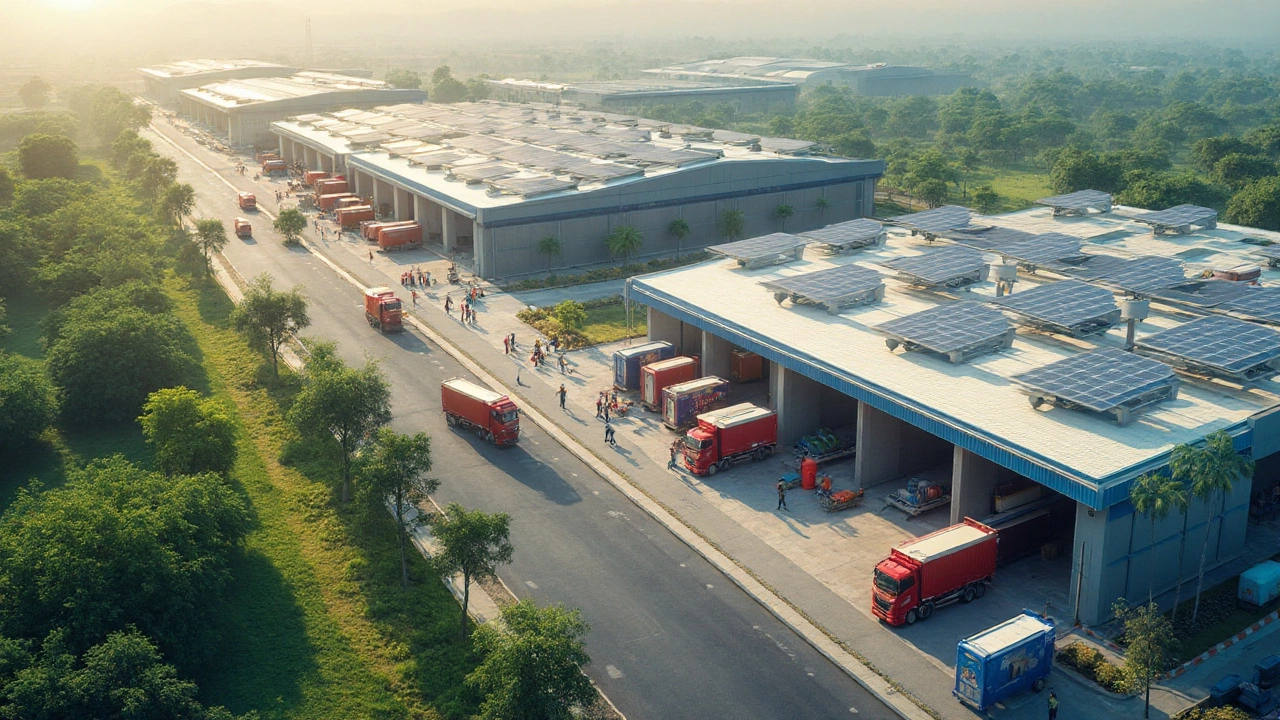Best Commercial Property Investments for ROI in 2025: Expert Insights

Buying commercial real estate is like playing chess instead of checkers—there's more to think about, and your moves can either reap serious rewards or leave you out of pocket. Investors are always chasing one big metric: ROI, or return on investment. That’s the number that tells you if your dollars are working for you—or just taking the afternoon off. The kicker is, not every commercial property is created equal, especially when it comes to making you money in the real world. If you walk into a property seminar or talk to local agents here in Auckland, you're likely to get a dozen different opinions on what’s "hot." But if you want to skip the tired cliches and focus on what really works in 2025, you’ve come to the right place.
The Current Landscape of Commercial Property ROI
Let’s cut to the chase—COVID-19 flipped commercial real estate upside down. Office buildings, once king, suddenly looked risky with everyone doing Zoom calls from their living rooms. Fast forward to today, and we’ve learned a few things: not all commercial assets bounce back the same, and what screams opportunity for one investor looks like a money pit for another. In New Zealand, retail struggled in the early 2020s but came out surprisingly resilient, especially suburban strips and convenience retail. We saw big-name office towers take a hit, as companies cut back on swanky head offices and trimmed lease commitments. Meanwhile, self-storage—something most people ignored—shot up in value, thanks to small businesses pivoting and a boom in online shopping.
According to Colliers New Zealand's 2025 market report, industrial property kept its spot at the top of the heap, with average yields holding strong at 5-6%, and prime logistics space dipping to under 4% in parts of Auckland. Compare that to prime office yields, which hover closer to 6% and face more risk due to flexible work trends. Neighborhood shopping centers, especially ones anchored by a supermarket, sit at about 5.5% yield for quality stock. But what does this mean for you? The numbers confirm what local investors have been whispering for the past year: high warehouse demand, steady retail anchored by essentials, and niche properties like medical centers are where the smart money’s going. Industrial, with its low vacancy rates and stable tenant demand, seems to be wearing the ROI crown right now for everyday investors, not just big institutions.
But location can flip the odds. Take South Auckland, where logistics hubs stack up container after container, serving everything from e-commerce giants to food distributors. The rental rates keep climbing, even as other commercial types stall. The secret sauce? You need to keep your finger on the pulse of zoning decisions, nearby infrastructure upgrades (think new motorways, rail spurs), and, of course, tenant quality. You can have the shiniest warehouse in the wrong part of town and still struggle to keep it full. On the flipside, a modest logistics unit in the right spot could have a queue of tenants willing to pay a premium. It pays to know your market, literally.
Types of Commercial Property Investments: Pros and Cons for ROI
Let’s break down the major types of commercial property—because not all are built equal when it comes to *highest ROI*. Traditional wisdom puts office, retail, industrial, and specialty properties (like medical or data centers) in different buckets. Truth is, they all run at different speeds in 2025, so what you pick really impacts your returns—and stress levels. Let’s be real: the easiest path isn’t always the best for ROI.
- Industrial/Warehouse: You’re riding a wave here, especially with “last-mile” logistics. People want their online orders yesterday, which pumps up rental demand near population centers. These spaces are simple, predictable, and easier to lease to multiple tenants. The repairs are rarely rocket science—no fancy lifts or plush carpets to replace. Vacancy rates? At historic lows. The biggest downside? Purchase prices have spiked, which can dampen your yield if you buy late in the cycle.
- Retail: Forget big malls—they’re struggling. But service-based retail (think barbers, physios, restaurants) and local strip centers anchored by a big supermarket or bottle shop are holding up better than many expected. You get steady foot traffic, and tenants who still value physical presence after lockdowns. The risk? If you get stuck with a fading retail strip, you could be in for long vacancies.
- Office: This is the wild card now. Prime CBD towers with blue-chip tenants are still trading, but smaller tertiary offices are getting hammered by hybrid work. High vacancy rates are forcing landlords to offer sweeteners like rent holidays. If you snag a bargain and can reposition a building, there’s upside. Just don’t bet the farm on an office comeback.
- Specialist Property: Medical centers, veterinary clinics, and childcare facilities are solid bets for steady cashflow. These tenants sign longer leases and invest heavily in fit-outs—hard to shift to another site. Yields run slightly lower, but reliability is the trade-off.
- Self-Storage and Data Centers: These have become the new black. Data centers are out of reach for most investors, but storage units, especially near growing suburbs, are more achievable. High demand, low staffing costs, and regular rent increases mean strong numbers. You do have to keep on top of security and maintenance, but that's true with any property, really.
If you’ve got $1M to invest, odds are best with industrial warehousing or essential-service retail, based on current trends. Those two tend to blend a solid yield with low vacancies—a rare combo in commercial property. It’s the safe play, even if the sexy big office towers look tempting on paper.

Calculating ROI: What Actually Matters?
ROI sounds simple, right? You compare how much you spend with what you get back each year. But with commercial property, the devil dances in the details. It's not just about rent collected minus expenses. You need to factor in stuff like outgoings (rates, insurance, maintenance), vacancy periods, capital expenditure for things like roof replacements, and, in NZ's case, seismic upgrades. Then, there’s the cost of borrowing—mortgage rates aren’t as generous as they were back in 2021, and the Reserve Bank could raise them again.
The basic ROI formula is:
- ROI = (Net Operating Income / Total Investment Cost) x 100
Net Operating Income (NOI) is your rental income, minus those pesky operating costs. Don’t forget, many leases in New Zealand are what’s called “net leases,” where the tenant pays most outgoings, but you’re still on the hook for big repairs. Here’s the trick—not all properties collect rent reliably. Digital businesses might be here today, gone tomorrow. A bakery or medical clinic, on the other hand, isn’t going anywhere fast. Pick tenants—not just buildings. Always check the lease expiry dates and rent review mechanisms. Those can make a world of difference to your cash flow and resale value.
Also, property values in Auckland can move quickly, even faster outside the city. If you hold a place for five years and ride a 30% capital gain, your real ROI blows away basic rental calculations. But talk to anyone who owned empty office space in Wellington since 2022, and they’ll tell you capital growth isn’t guaranteed. The "set and forget" days are over. You need to actively manage risk, keep an eye on debt, and lock in quality tenants to see real returns.
Tips for Boosting Your Commercial Property ROI
Even if you nail your purchase, you can still leave money on the table if you don’t actively work your property. Here’s how to get the most out of your investment in 2025, no matter your budget.
- Upgrade Wisely: Little improvements fill vacancies faster and push up rent. Fresh paint, good signage, or LED lighting can bump up street appeal and slash energy costs. I added solar to a warehouse my mate bought—it paid for itself in two years and tenants love the green tick.
- Reconsider Layouts: If you’ve got a big warehouse, consider splitting it into smaller tenancies. Smaller businesses are multiplying, and they’ll pay a premium for flexible, bite-sized units.
- Add Amenities: Secure parking, high-speed internet, and smart access control—even a shared coffee machine—can keep tenants happy and renew leases. Simple things add real value. Tenants notice when you care, and they stick around longer.
- Get Ahead of Regulation: Seismic safety, new fire rules, healthy building standards—they’re not glamorous, but they sink latecomers. Stay updated so you’re never racing to retrofit at the last minute. In Auckland, councils clamp down harder each year, so compliance is half the battle.
- Look for Undervalued Locations: Growth corridors like Drury, Silverdale, or Hamilton’s northern fringe offer better entry prices and strong rental demand. Get ahead of government infrastructure projects, like new train links or highways, and you’ll buy cheap before the crowds show up.
- Negotiate Smart Leases: Push for market reviews, CPI increases, and tenant responsibility for outgoings. Squeeze value from every clause—sometimes a two-page lease costs you ten grand in lost rent down the track.
Leverage your professional team. Even if you’re the DIY type, a sharp commercial lawyer and experienced property manager save you more than they cost, especially when chasing tough tenants or dealing with disputes. Commercial property is not just about collecting rent—it’s about being nimble and hands-on, especially if you want to outpace the average investor.

Biggest Risks: What to Watch Out For in 2025
ROI isn’t just about what you make—it’s about what you don’t lose. Even top-tier warehouse investments come with curveballs. The biggest risk in 2025? Overpaying in hot markets. FOMO can be brutal. If you buy at the peak, it can take years of steady rent to claw your way back. Don’t let hype cloud your judgment. Use real market data, not just flashy listings.
Tenant risk is huge now. We saw stable brands go broke during lockdowns, and demand can change overnight. Industrial tenants look bulletproof, but a big warehouse relies on a handful of contracts. Lose your anchor, and it’s a scramble. Diversify your tenant base where you can, even if it means more management work.
Regulatory risk can also take a bite. Kiwi councils keep tightening the screws on safety standards, green upgrades, and property uses. Miss an inspection deadline or ignore a letter about earthquake-prone buildings, and you’ll pay for it—sometimes double. Even market darling types like self-storage face competition from new builds and zoning changes.
Interest rates are creeping up, so locking in low rates makes sense now. Just make sure you stress test your numbers. Ask—what if rents dip for two years? What if you wear two months' vacancy? If you’re banking on perfect conditions, that’s not investing, that’s gambling. Cash reserves and backup plans are the difference between a student mistake and a rainmaker move.
Finally, don’t forget the "X factor"—stuff like floods, a tenant scandal, or sudden changes in online retail. Earlier in 2025, a massive Auckland warehouse flooding saw four tenants walk out. Insurance covered repairs, but filling those bays again took six months. Plan for the things you can’t control, and you’ll sleep better at night—even when a headline throws everyone else into panic mode.







Write a comment